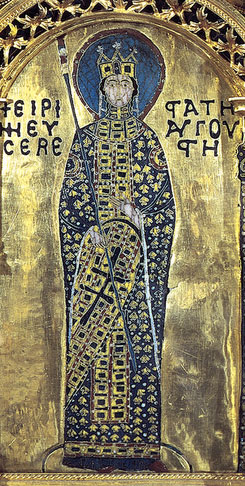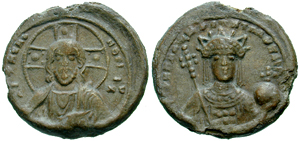Irene Doukaina facts for kids
Quick facts for kids Irene Doukaina |
|
|---|---|

Probable representation of Irene Doukaina from the Pala d'Oro in St Mark's Basilica in Venice, Italy
|
|
| Empress consort of the Byzantine Empire | |
| Tenure | 4 April 1081 – 15 August 1118 |
| Born | c. 1066 Constantinople (modern-day Istanbul, Turkey) |
| Died | 19 February 1138 (aged 71–72) |
| Spouse | Alexios I Komnenos |
| Issue |
|
| House | Doukas |
| Father | Andronikos Doukas |
| Mother | Maria of Bulgaria |
Irene Doukaina (born around 1066, died February 19, 1138) was a powerful Byzantine empress. She was married to Alexios I Komnenos, who was the Byzantine emperor. Irene was also the mother of Emperor John II Komnenos and the famous historian Anna Komnene.
At first, Irene's mother-in-law, Anna Dalassene, had a lot of power and influence. This made Irene feel less important. But after Anna Dalassene retired and passed away, Irene gained more influence over her husband, Alexios I. She became very powerful towards the end of his rule. However, she couldn't choose who would become the next emperor. She wanted her daughter Anna Komnene to rule, but her son John II Komnenos became emperor instead.
Contents
Life of Empress Irene
Irene was born in 1066. Her father was Andronikos Doukas, and her mother was Maria of Bulgaria. Andronikos was related to Emperor Constantine X Doukas.
Becoming Empress
Irene married Alexios in 1078 when she was only eleven years old. Because of this marriage, Irene's family, the Doukas family, supported Alexios. This happened in 1081 when there was a fight for the throne after Emperor Nikephoros III Botaneiates stepped down.
Alexios' mother, Anna Dalassene, really disliked the Doukas family. She tried to make Alexios divorce Irene and marry Maria of Alania. Maria had been married to two previous emperors.
Irene was even stopped from attending Alexios' coronation ceremony. But the Doukas family convinced the head of the church, Kosmas I, to crown her too. He did this one week later. Anna Dalassene agreed but forced Kosmas to resign right away.
Life as Empress
Alexios' mother, Anna, continued to live in the palace. She kept interfering in her son's decisions for 20 years until she died. There were also rumors that Alexios had a relationship with Maria of Alania. However, Irene's daughter, Anna Komnene, wrote that this was not true. Anna Komnene was born two years later, in 1083.
Anna Komnene greatly admired her mother. She described Irene in detail, saying she was very beautiful. Anna wrote that Irene stood tall and graceful, like a young tree. Her face was soft like the moon, not too round or too long. She had rosy cheeks and light-blue eyes that were both cheerful and serious. Her hands were elegant, like ivory.
Anna Komnene even wrote that Irene was so perfect, it was like the goddess Athena had appeared to people.
Irene was a bit shy and preferred not to appear in public. But when she had to act as empress, she was strong and firm. She liked taking care of her home and enjoyed reading stories about saints. She also gave money to monks and people in need.
Even though there were rumors about Alexios and Maria early on, his daughter Anna said that Alexios and Irene truly loved each other later in their marriage. Irene often went with Alexios on his trips. This included a trip against Prince Bohemund I of Antioch in 1107. She also went to the Chersonese in 1112. On these journeys, she helped nurse her husband when he had foot pain.
Anna Komnene also said that Irene acted like a guard for Alexios. This was because there were always plots against him. Alexios might have wanted Irene to be with him on campaigns because he didn't fully trust her to stay in the capital. When she did stay in Constantinople, she acted as a regent. This meant she ruled in his place, with her son-in-law Nikephoros Bryennios the Younger as her advisor.
Empress Dowager and Later Life
Irene often tried to convince Alexios to name her daughter Anna and her husband Nikephoros Bryennios the Younger as his heirs. She wanted them to rule instead of her younger son, John II Komnenos. A historian named Niketas Choniates said that Irene "used all her influence" to support Anna. He wrote that Irene often spoke badly about John, calling him reckless and weak.
Alexios, however, wanted his own son John to be the next emperor. He usually ignored Irene's suggestions or pretended to be busy. Sometimes, he would even get angry and scold her for bringing it up.
Irene took care of Alexios when he was dying in 1118. Even then, she was still trying to get Anna and Nikephoros to become the next rulers. Alexios had already promised the throne to John. When John took his father's special ring, Irene accused him of being a thief.
When Alexios finally died, Irene was truly sad. She wore the mourning clothes of her daughter Eudokia, whose husband had died earlier. However, Irene soon started plotting with Anna against John. Their plans didn't work. Both Irene and Anna were then sent to live in the Kecharitomene nunnery. Irene had actually founded this nunnery a few years before.
It wasn't a harsh exile. Irene lived there peacefully. She gave food to the poor and helped educate young orphan girls. Irene might have encouraged her son-in-law Nikephoros Bryennios to write his history. She also communicated with or supported important writers like Theophylact of Ohrid.
In Literature
The famous modern Greek poet Constantine Cavafy mentions Irene Doukaina in his poem "A Byzantine Nobleman in Exile Composing Verses." In the poem, he calls her "that viper Irini Doukaina." The poem suggests she was the reason the nobleman was sent away. This shows her reputation as someone who made plans and schemes.
Children
Irene passed away on February 19, 1138. She had nine children with Emperor Alexios I Komnenos:
- Anna Komnene (1083–1153)
- Maria Komnene
- John II Komnenos (1087–1143)
- Andronikos Komnenos
- Isaac Komnenos
- Eudokia Komnene
- Theodora Komnene, who married Constantine Angelos. Their children included John Doukas, who was the father of the first two rulers of the Despotate of Epirus. These rulers were Michael I Komnenos Doukas and Theodore Komnenos Doukas. Another child was Andronikos Doukas Angelos, who was the father of emperors Isaac II Angelos and Alexios III Angelos.
- Manuel Komnenos
- Zoe Komnene
Sources
- "The Oxford Dictionary of Byzantium".. (1991). Oxford and New York: Oxford University Press.
- Anna Comnena, The Alexiad, trans. E.R.A. Sewter. Penguin Books, 1969.
- Choniates, Nicetas (1984). O City of Byzantium, Annals of Niketas Choniatēs. Detroit: Wayne State University Press. ISBN 0-8143-1764-2. https://books.google.com/books?id=O8arrZPM8moC.
- Georgina Buckler, Anna Comnena: A Study. Oxford University Press, 1929.
- Thalia Goumia-Peterson, "Gender and Power: Passages to the Maternal in Anna Komnene's Alexiad ", in Anna Komnene and Her Times, ed. Thalia Goumia-Peterson. Garland Publishing, 2000.
- Treadgold, Warren (1997). [Irene Doukaina at Google Books A History of the Byzantine State and Society]. Stanford, California: Stanford University Press. ISBN 0-8047-2630-2. Irene Doukaina at Google Books.
|
Irene Doukaina
Doukas
Born: c. 1066 Died: 19 February 1138 |
||
| Royal titles | ||
|---|---|---|
| Preceded by Maria of Alania |
Byzantine Empress consort 1081–1118 |
Succeeded by Irene of Hungary |
See also
 In Spanish: Irene Ducas para niños
In Spanish: Irene Ducas para niños


